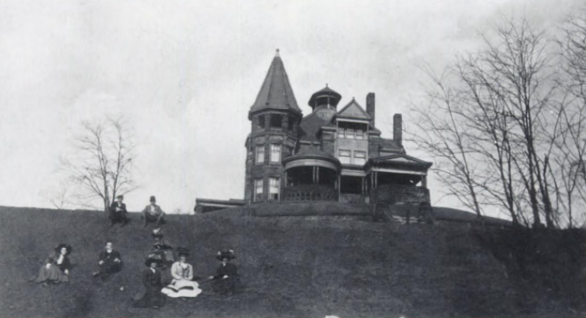Frank Case (1850-1933) / Albert Saddler
Canton Artists
Early Canton • Oil on Canvas 48” x 84”
There is a large limestone wall along Market Ave. N, near 15th St. If only those stones could talk. On the hill above that wall once sat a magnificent mansion built to woo a woman. Theano must have been a beauty, because she caught the eye of two very successful businessmen in town. To decide who to marry she issued a challenge. Whichever one built the largest house would win her hand in marriage. Yes, in this case, size mattered.
The first man, Frank Case, started as a bad lawyer and became a good businessman. He invented the first reclining dental chair and made a fortune. The second man, Zebulon Davis invented gasoline-powered products and produced the first carburetor for the Winton Automobile. He also founded the Standard Lighting Company in Cleveland. By 1892 he had formed the Diamond Portland Cement Company in Middlebranch, northeast of Canton.
So, the two titans of Canton industry set out to win themselves a wife. They built mansions on adjacent lots just north of downtown Canton. Case’s home was solid stone and looked like a castle. Davis built an enormous Victorian. But, before Davis even finished his, Theano judged Case’s home larger and decided he was the man of her dreams. Davis never even finished his house and remained a bachelor until his death, at age 87.
(story continues below break)
INTERESTING STORIES FROM OUR SPONSORS

Case and his hard-won wife moved into the large stone mansion, where he became an amateur artist. Unfortunately, as almost any artist in town would have told him, art does not pay as well as dental chairs, and his fortune dwindled. He died penniless in 1932, one year after Davis. A neighbor, Frederick Preyer purchased the Case Mansion and donated it to be the first permanent home of the Canton Institute of Art, now known as the Canton Museum of Art.
Early Canton was one of the paintings, left behind in the mansion and, until 1975, Frank Case was thought to be the artist. Then Albert Saddler, step-son of Cases’s gardener “set the story straight.” “True, Mr. Case was an amateur painter and had just sketched in a few buildings when he suffered a stroke. Unable to paint, but determined that his memory of downtown Canton be preserved, he ‘dictated’ the image to me.”
If only those stones could talk …
Canton Museum of Art Permanent Collection
Purchased by the Canton Art Institute (Now the Canton Museum of Art) 42.6
4 Ways to Sound Smart When Viewing at The Canton Museum of Art
1.
“Case started this painting but suffered a stroke after sketching in a few buildings. Albert Saddler finished it as Case directed him.”
2.
“This painting represents Frank Case’s memories of downtown Canton at the end of the 19th Century. Of course, his memory was possibly clouded by a stroke.”
3.
“Case was a successful businessman who died penniless. His mansion was purchased by a neighbor and donated to become the original home of the Canton Museum of Art.”
4.
“Case was a lousy lawyer, great businessman, amateur artist and great art patron. 2 out of 4 ain’t bad!”
Case Timeline. Scroll over images to see timeline.











